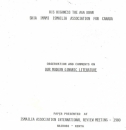¤ Books
GIRBHAVALI BY PIR SADRUDDIN (TRANSLITERATION, TRANSLATION & EXPLANATION)
Five imaginary interrogations of the goddess Parvati to the Divine Lord (Ishavar Sami) on cosmology, cosmogony, embryology, physiological deliberations and human anatomy.
- 1729 reads
Evolution and re-evaluation of the Ismaili Du’a following the Declaration of the Great Resurrection in Alamut.
Evolution and re-evaluation of the Du’a (Prayer ) of the Nizari Ismailis in the subcontinent following the Declaration of the Great Resurrection in Alamut.
There is also a video of this presentation on: https://youtu.be/jjt392ZrXcw
This paper was first presented during the 3rd Ismaili Study Conference in 2021.
- Read more
- 3213 reads
The Genealogy of the Imams since Creation based on the Ghat Pat-ni Dua written by Pir Sadardin (1300-1400 AD)
1) A MUST READ. This "Volume 1: Basis of the Ismaili Doctrine" by Nargis Mawjee explores in depth the Ismaili doctrine + the genealogical tree of the Ismaili Imams since the creation as recorded by Pir Sadardin in his Asal Ghat Pat ni Dua, the 3 time daily prayer recited by Ismailis during 6 centuries in jamatkhana until 1957.
- Read more
- 2105 reads
Hoosenally Rahimtoola
Hoosenally Rahimtoola
Hoosenally Rahimtoola was born in May 1890 to a merchant trading family who were well established politically in Bombay. Being the first male grandchild in the family he was brought up by his elder uncle Mohammadbhoy Rahimtoola.
Rahimtoola schooled at St. Xavier’s High School Bombay followed by obtaining his Bachelor’s degree in Arts from Bombay University [1911].
- Read more
- 5822 reads
Mystical Elements in "Satvenni Motti" of Sayed Nur Muhammad Shah
Mumtaz Ali Tajjdin Sadik Ali has built his credibility since decades in the field of Ginanic studies in which he has become one of the experts of our times.
Mumtaz Ali has written this short 16 pages analysis of Satvenni Motti (Satveni Moti) Granth and released it on Navroz (21st March) 1996. After a brief introduction on Nur Muhammad Shah, he goes on in showing the various concepts covered in Motty Satvenni with some verses translated ending in comparing with concepts put forth by Pir Sadardin and explaining in detail the process of Meditation supported by the "Jap", the "Word".
- Read more
- 7671 reads
Ismailism in Multan and Sind
This is an article about the expansion of Ismailism in Multan and Sind since Dai Hatim was sent to these areas in 883AD (Fatimid took power in Maghreb in 909 AD). The expansion continued later under Dai Jalam b. Shayban( http://ismaili.net/heritage/node/2187) who seize Multan for the Fatimid Imams in 985 AD.
- Read more
- 7412 reads
A Fatimid Decree of the Year 524 AH/1130 AD
The large collection of the Turkish and Arabic manuscripts at the St Catherine Monastery in Sinai contains several Decrees issued by various Fatimid Caliphs and in particular Mustealian Fatimid Caliphs. In some of those we find confirmation of the covenant of Prophet Muhammad with the Christians for their protection. Stern publishes here one of the Decree of the Regent Abd al Majid in this article.
A PDF download is available from the link below.
- 7590 reads
Le Si'isme au IXe s. à travers l'histoire de Ya'qubi
L'article par Yves Marquet est en Francais. Vous pouvez le lire en cliquant ci-dessous sur le lien en format PDF. (1ere partie de l'article: page 1 - 45)
This is an article in French by Yves Marquet.. The article is about Ya'Qubi (d.897AD), a geographer, historian and author of Shia/Ismaili persuasion who was writing at the second half of the ninth Century, that is before the advent of the Fatimids.
- Read more
- 6662 reads
Feki, Habib: Les idées philosophiques et religieuses de l'Ismaélisme fatimide - Thèse de Doctorat a Paris
Une Thèse de Doctorat présentée en 1972 a Paris, d’une valeur exceptionnelle, basée sur des manuscrits ismaéliens inédits avec l’aide de sommités tels que le Professeur Henry Corbin et Georges Vajda.
- Read more
- 7523 reads
Ismailia Association International Review Meeting Nairobi 1980
Follow-up to Paris Conference 1975. The 1980 Nairobi Ismailia Association International Review Meeting.
This is the paper presented at the Ismailia Association International Review Meeting in Nairobi, Kenya on 1980 by the Ismailia Association for Canada.
- Read more
- 10043 reads
End of the Book of ANasir-i Khusraw, Forty Poems From The Divan@
End of the Book of ANasir-i Khusraw, Forty Poems From The Divan@
- 4219 reads
Bibliography
Abu Ya qub Sejestani, Kasf al-Mahjub - Le Devoilement des Choses Cachees, ed., by H. Corbin Tehran-Paris, 1949.
Corbin, H., Au pays de l Imam Cache , Eranos-Jahrbuch, vol. 32, 1963, pp. 31-87.
Corbin, H., De la philosophie prophetique en Islam Shi ite , Eranos Jahrbuch, vol, 31, 1992, pp. 49-116.
Corbin, H., De la situation philosophique du Shi isme , Islamic Studies, Vol. 2, 1963, pp. 75-94; and Le Monde non-chretien, Vol. 70, 1964, pp. 61-86.
- Read more
- 5024 reads
6. VI DEVOTION
In Praise of Ali (1) ; MM.LXXXV
Line 16: Nasibi; an enemy of Ali; NK uses him for the type of an anti-Shi ite.
Line 29: Hunayn; one of the famous battles of the Prophet of Islam against the unbelievers.
Line 45: the unbelievers of Mecca; i.e., those Arabs who did not accept the Prophet and forced him to emigrate to Medina.
Line 48: the best woman in the world; Fatimah.
Line56: Badr, Uhud and Khaybar; three battles waged by the Prophet against the ubelievers.
In Praise of Ali (2) ; MM.LXXXII
- Read more
- 3108 reads
5. V AUTOBIOGRAPHY
Autobiography ; MM.LXXIX
A Warning to Missionaries ; MM.LXVIII
Dissimulation ; MM XXXIII
title: Dissimulation (taqiyyah); Shi ites are allowed, in case of danger, to disguise their adherence to the minority faith in order to escape persecution. Ismailis made particular use od this.
Line 55: Ramadan; the month during which fasting from dawn to sun-down is obligatory for all Muslims.
Line 67: Shari ite; i.e. followers of the Shari ah, the Sacred Law.
In Yamgan ; MM.IX
- Read more
- 2802 reads
4. IV SATIRE
a Wasted Pilgrimage , MM.CXLI
Line 5: Arafat; a plain near Mecca where pilgrims must spend one day of the Hajj in prayer and invocation.
Line 7: the Hajj; the Pilgrimage to Mecca, incumbent on all Muslims at least once in their lifes for those who can afford it.
Line 15: Haji; one who has completed the Pilgrimage, a title of great respect.
Line 19: pilgrim s robe; on the Pilgrimage, everyone wears two simple pieces of white cloth, similar to the shroud.
- Read more
- 3100 reads
3. III WORDS OF WISDOM
Words of Wisdom ; MM.XLIX
A Parable of Jesus ; MM.CCL
On the Qur an ; MM.V
Line 108: drylipped before the Euphrates; a reference to the fate of the Third Imam, Husayn, who was killed along with may of his followers in Karbala - now a city in Iraq - by the army of the Umayad Caliph Yazid after having suffered extreme thirst, kept by his enemies from obtaining water from the nearby river Euphrates. The foes of the Household are punished by being refused the esoteric knowledge of the Imams.
Line 117: Sultan of khan; worldly rulers.
Ode to Night ; MM.CCXXX
- Read more
- 3232 reads
2. II PHILOSOPHY
The First Poem ; MM.I
Line 74: Harut; and Marut, two evil demons who taught sorcery to the Babylonians.
Line 122: the elements, Earth, Air, Fire and Water can be considered as [airs of opposites, yet all exists together in harmony on the material plane.
Speech ; MM.II
Line 18: Darius; the name of several Persian kings, especially Darius the Great, the Achaemenian (d. 486 B.C.)
Line 45: Sanaa (San a ); the capital of Yemen, used as a figure of a far-away place.
- Read more
- 3545 reads
1. I INTRODUCTION
The Diwan ; MM. CLXXVII
Line 5: Diwan (The Diwan); a collection of poetry. Elsewhere NK refers to his two divans ; they have been combined into one.
Line 62: Solomon is famous for his magical control over the jinn, psychic being or fire elements, some of who are good, or at least neutral, while others are demonic.
Line 66: Luqman; a wise man, said to have been a son of Job s sister or aunt, a disciple of David, or a judge of Israel, or a freed Ethiopian slave.
Line 68: The Threshold of the Compassionate; i.e., the Divine Presence
- Read more
- 2758 reads
Notes on the Poems
Nasir-i Khusraw did not give his poems titles, but we have decided to title them in order to clarifyy their main themes and make it easier to refer to them individually. In the notes, the title will be followed by MM and a number; this refers to the number of the poem in the edition of the Diwan edited by M. Mnovi and M. Mohaghegh, Tehran, 1353 A.H.S.
There are 6 notes, each one for a one poem section
- 4208 reads
3. In Praise of the Prophet
I choose
the Quran
and the Faith of Muhammad
for those
where the choices
of Muhammad himself;
I know
if I practise the two
my Certainty
will become
as the Certitude
of the Prophet.
My key
to Paradise - my guide
to Felicity
the fortified Citadel:
what are they but
the Religion of Muhammad:
For us
he is the Messenger
of God - such
was the carving
on the seal-ring
of the Prophet.
Rooted in my heart:
the Faith
and the Book
as firmly
as in the heart
of Muhammad.
By God s Grace
my hope, my prayer
- Read more
- 3256 reads
 Ismaili.NET - Heritage F.I.E.L.D.
Ismaili.NET - Heritage F.I.E.L.D.





